Schnitzel
A schnitzel is a thin slice of meat fried in fat. The meat is usually thinned by pounding with a meat tenderizer. Most commonly, the meats are breaded before frying. The breaded schnitzel is popular in many countries and made using veal, pork, chicken, mutton, beef, turkey, or textured vegetable protein as a vegan alternative. It is very similar to the dish escalope in France, tonkatsu in Japan, and the milanese of Italy, Mexico, Uruguay, Paraguay, Argentina, Brazil and chicken fried steak of the American South.
Schnitzel | |
| Main ingredients | Meat |
|---|---|
| Ingredients generally used | Fat |
| Variations | Wiener Schnitzel |
Etymology
The German word schnitzel (Middle High German: snitzel) is a diminutive of sniz, 'slice'.[1] The name Wiener Schnitzel is first attested in 1845.[2]
Wiener Schnitzel
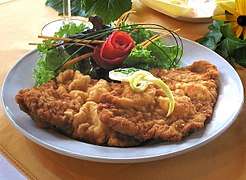
Wiener Schnitzel is a popular Viennese dish made of veal and traditionally garnished with a slice of lemon and either potato salad or potatoes with parsley and butter.
In Austria and Germany, Wiener Schnitzel is a protected geographical indication and must be made of veal.[3] When other meats are used, it can be called Wiener Schnitzel vom Schwein/Pute/Huhn ("Viennese Schnitzel of pig/turkey/chicken") or Schnitzel nach Wiener Art ("Schnitzel Viennese style").
Worldwide schnitzels
The English term schnitzel means in general all types of breaded, fried flat pieces of meat. Due to the similarity between schnitzel and escalope, in many of the countries listed below, people sometimes refer to schnitzels as escalope, and vice versa.
Australia
Beef (which may be veal) and chicken schnitzel are both very popular dishes in Australia, particularly in pubs where they are among the most widely available meals. Chicken schnitzel (less so beef) is also sold at many take-away establishments.
Schnitzel in Australia is often served in the form of parmigiana, which is a schnitzel topped with Italian tomato sauce, cheese, and occasionally ham.
At pubs, schnitzel is typically accompanied by chips (French fries), salad, and sometimes bacon. Plain and parmigiana schnitzels are sometimes respectively known by colloquial names "Schnitty", "Schnitter", "Parma", or "Parmi".
Austria
Wiener Schnitzel, a very thin, breaded and pan fried cutlet made from veal, is one of the best known specialities of Viennese cuisine, and is one of the national dishes of Austria.[4][5]
Other popular breaded or unbreaded variants in Austria are:
- Jägerschnitzel (hunter's schnitzel) is a schnitzel with mushroom sauce.
- Rahmschnitzel (cream schnitzel) is a schnitzel with a cream sauce, often containing some mushrooms.
- Zigeunerschnitzel (gypsy schnitzel) is a schnitzel with a zigeuner sauce containing tomato, bell peppers, and onion slices.
Bosnia and Herzegovina
In Bosnia and Herzegovina, the dish is called Bečka Šnicla or Bečki Odrezak (Bečki = "Viennese"; Šnicla = transliteration of German Schnitzel) and is made of veal or beef and usually served with mashed potatoes. Common garnishes include a slice of lemon or some lettuce.
Brazil
In Brazil, such preparations, designated à milanesa (Milanese-style), are quite common, especially in the more European-influenced southern region of the country. The meats of choice are beef or chicken, while veal and pork are relatively rare.
Bulgaria
Called шницел (shnitsel), it is made from ground veal, formed as a thin patty, seasoned with salt and black pepper, then breaded and fried. The dish usually is served with a choice of mashed or roasted potatoes, French fries, or simply a tomato salad. It is common at truck stops, and it is usually ordered à la carte, coming with a lemon wedge, but one can also find it in the frozen sections in supermarkets or premade and ready to cook.
Canada
In Canada, Schniztel is often referrred to simply as Veal Cutlet or Chicken Cutlet, breaded and fried. Often with Italian tomato sauce, parmigiana cheese or mozzarella cheese. It is often topped with red peppers and it is very commonly served as a sandwich.
Colombia
Schnitzel presentations are called chuleta in Colombia. They are composed of flat pieces of chicken, veal, or mostly pork, covered with flour, and then deep-fried. The chuleta is a traditional dish of the Valle del Cauca region.
Croatia
In Croatia, the dish is called Bečki odrezak (šnicl) (Bečki = "Viennese"; šnicl = transliteration of German Schnitzel) and it is made of pork and served with French fries. Common garnishes include a slice of lemon or some lettuce. A similar dish is called Zagrebački odrezak (šnicl) (a variation on cordon bleu).
Czech Republic
Schnitzel is also very popular in the Czech Republic, where it is known as a smažený řízek or just řízek, and is made of pork, chicken, or veal. It is often served with boiled or mashed potatoes or potato salad. It also used to be and to some degree still is a typical packed lunch for day trips, when it was consumed with bread (often between two slices of bread as a sandwich). During the communist period, a deep-fried breaded hard cheese called smažený sýr (literally, "fried cheese") became popular, mainly among the youth and students, especially served with tartar sauce, a slice of lemon, and boiled new potatoes with melted butter and parsley greens.
Denmark
In Denmark, the dish is called skinkeschnitzel when made of pork and wienerschnitzel when made of veal, and is usually served with fried potatoes, gravy, green or snow peas, and a "boy" (dreng in Danish) consisting of a lemon slice topped with capers, horseradish, and a slice of anchovy.
Egypt
In Egypt, there are two dishes called pane the first dish is called "chicken pané" or "فراخ بانى" in Arabic and is usually served with an Egyptian variation of lasagne called "macarona béchamel" or "مكرونة بشاميل" in Arabic. It is also popular with french fries, in sandwiches, or eaten alone as an appetizer. Using meat, it is called "بفتيك". and the other one is known panne which is with meet and usually served with french fries
Finland
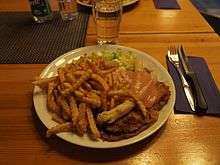
In Finland, the dish called Wieninleike ("Viennese cutlet"), is almost always made of pork, breaded and fried like the original. It is usually served with French fries, potato mash, or wedge potatoes. A slice of lemon, a slice of anchovy, and a few capers are placed on top of the cutlet. Usually the dish includes a small amount of salad made from fresh vegetables. The dish was popular between the end of the Second World War and the 1990s, when it could be found in most low-end restaurants in Finland. In past decades, its popularity has been dimmed by the rise of fast food.
Wieninleike and its variations remain a staple of menus in many non-ethnic or fine dining restaurant in Finland. Lunch restaurants, highway rest stops and restaurants attached to gas stations are most prominently associated with this type of menu in Finland.
- Wieninleike served typically with slice of lemon, anchovy, and caper
- Floridanleike served with fried peach and served with Béarnaise sauce
- Havaijinleike served with fried pineapple
- Holsteininleike served with egg, anchovy, and caper
- Metsästäjänleike served with mushroom sauce
- Oskarinleike served with choron-sauce, shrimps or lobster, and asparagus
- Oopperaleike served with fried egg
- Sveitsinleike is filled with smoked ham and Emmentaler cheese
Typically the dishes above are prepared from pork.
France
Pariser schnitzel is similar to Wiener Schnitzel but is floured and fried in an egg batter instead of using breadcrumbs.
Germany
In Germany, the term Schnitzel means cutlets in general, not just breaded, fried ones.
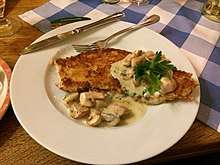
- Jägerschnitzel (hunter's schnitzel) is a schnitzel with mushroom sauce. Depending on the region of Germany and personal taste, it may or may not be breaded. (Jägerschnitzel may also refer to an eastern German variant made of Jagdwurst, which originated in East Germany.)
- Schnitzel Wiener Art is not made from a veal escalope but instead a pounded, breaded and fried pork cutlet cooked in the same style. It's mostly served along with french fries and a lemon slice.
- Münchner Schnitzel (Munich schnitzel) is a variation on the Wiener Schnitzel prepared with horseradish and/or mustard before coating in flour, egg and bread crumbs.
- Rahmschnitzel (cream schnitzel) is a schnitzel with a cream sauce, often containing some mushrooms.
- Zigeunerschnitzel (gypsy schnitzel) is a schnitzel with a zigeuner sauce containing tomato, bell peppers, and onion slices. This schnitzel is also called Paprikaschnitzel (bell pepper schnitzel), Schnitzel Balkan-Art (Balkan-style schnitzel) or Schnitzel Budapester Art (Budapest-style schnitzel). Much like the English term "gypsy", the term Zigeuner is viewed as offensive by some Romani people.
Hungary
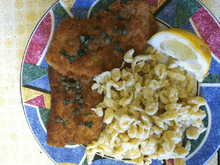
Due to the strong Austrian influence of the Austro-Hungarian era, Wiener schnitzel is popular in Hungary, known as bécsi szelet[6] (Viennese slice), borjú bécsi (Viennese veal) or rántott hús (breaded meat). It is served in restaurants, and is a common meal in Hungarian homes, often prepared on Sundays or for festivities with spätzle, French fries, mashed potatoes, or rice. Alternatively, green peas or other vegetables are used as side dish. Bread and salad (or pickles) often accompany the meal. Some restaurants offer the cordon bleu variant, a slice of schnitzel rolled and filled with cheese and ham.
Iran
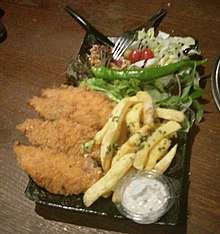
Schnitzel is popular in Iran, where it is known as shenitsel (Persian: شنیتسل). Thought to have been introduced in Persia during the World Wars, shenitsel is usually thicker, bigger, spicier, and fried with a more crispy breading than the standard schnitzel. It is customarily served with lemon, French fries, and a variety of boiled vegetables.
Another Iranian dish, kotlet (Persian: کتلت), should not be confused with shenitsel. They are small, oval-shaped patties made by deep-frying a mix of ground meat, onion, potato, and herbs.
Israel
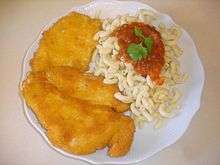
In Israel the dish is called Schnitzel (Hebrew: שניצל, shnitsel). It is a popular food in Israeli cuisine. The meat is typically chicken or turkey breast, in conformance with dietary kashrut laws, which prohibit pork. Additionally, clarified butter, the preferred cooking fat for Austrian Wiener Schnitzel, is impermissible for kosher use, as it is a dairy product forbidden for use with meat. Hence vegetable oils are used. Before frying, the schnitzel is coated with a mixture of beaten eggs and bread crumbs, sometimes spiced with paprika or sesame seeds. The Israeli schnitzel is usually served with mashed potatoes, French fries, rice, or pasta, accompanied by ketchup, hummus, or vegetable salad.
The schnitzel tradition was brought from Europe to Israel by Ashkenazi Jews. During the early years of the state of Israel, veal was not obtainable, and chicken or turkey proved to be inexpensive and tasty substitutes. Packaged schnitzels are widely available from the frozen food section in most supermarkets. Some frozen schnitzels are breaded patties made from processed chicken or turkey meat, not whole poultry breasts.
Schnitzel is also sold in a pita, alongside hummus, French fries and vegetable salad, in a similar way to falafel. Many falafel stands also offer a schnitzel in a pita.
Japan
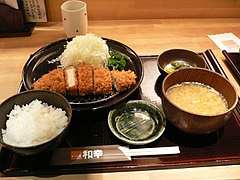
Japanese tonkatsu (豚カツ, lit. "pork cutlet") consists of a flattened pork loin, lightly seasoned, coated in flour, dipped in beaten egg, coated with panko crumbs and deep fried. Tonkatsu is often served as an accompaniment to ramen or udon or featured with curry and rice.
Pork tonkatsu was invented in Japan in 1899 at the Rengatei restaurant in Tokyo.[7][8][9] It was originally considered a type of yōshoku—Japanese versions of European cuisine invented in the late 19th and early 20th centuries—and was called katsuretsu (cutlet) or simply katsu.[10] Variations include the use of pork fillet (hirekatsu), chicken (chicken katsu), beef (gyūkatsu), ham (hamukatsu) and minced meat (menchi-katsu).
Korea
In Korean cuisine, pork (donkaseu, from Japanese tonkatsu), chicken (chikinkaseu), and beef (bipkaseu) cutlets are popular. The most common types of donkaseu are "kyeongyangsik"(경양식; Western-style) and "ilbonsik"(일본식; Japanese-style).
Latin America
In Latin American countries, this dish is called milanesa.
Argentina
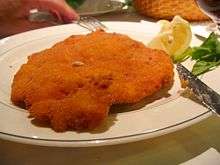
In Argentina, this dish, called milanesa or carne empanizada, consists of a thin slice of beef, chicken, veal, or sometimes pork, and even eggplant or soy. Each slice is dipped into beaten eggs, seasoned with salt, and other ingredients according to the cook's taste (like parsley and garlic). Each slice is then dipped in bread crumbs (or occasionally flour) and shallow-fried in oil, one at a time. Some people prefer to use very little oil and then bake them in the oven as a healthier alternative.
Lebanon
In Lebanon, the dish is normally called escalope. Escalope is a French term and is a broader category of beaten, breaded meat of which Schnitzel is a type of. While schnitzels are fried, escalopes need not be even though it most commonly is. Lebanon likely adopted the French term during the French mandate period of Lebanon.
Namibia
Schnitzel, both chicken and pork, is common in Namibia due to the German colonial history. A majority of the restaurants in Windhoek, Walvis Bay, and Swakopmund offer it on their menus, often topped with a fried egg and accompanied by potato salad. It is often eaten in a Brötchen (German sandwich roll) with tomatoes, cheese, and other dressing.
Netherlands
In the Netherlands (and Belgium) schnitzel is mostly made of pork and served with fries and vegetable salad. Zigeunerschnitzel (served with paprika) and Cordon bleu (Blue ribbon) are very popular. A typical Dutch variant is the 'gehaktschnitzel', a schnitzel made of minced meat. In the Netherlands every butcher has his own variants.
North Macedonia
In the Republic of North Macedonia, the dish called шницла (shnitzla) is a piece of pork seasoned with salt and black pepper, breaded and fried. Typically, it is served with mashed or fried potatoes with green salad garnish.
Poland
Kotlet schabowy is a classical and most popular recipe for boneless pork chop or pork tenderloin. It can also be made from chicken.
Portugal
In Portugal, schnitzel is called bife panado or just panado ("breaded"). Different varieties of panado can be made with chicken (panado de frango), turkey (panado de peru), pork (costeleta panada for pork chop, febra panada for pork without bone), or veal (escalope de vitela panado). The meat is usually seasoned with black pepper, garlic, and lemon juice. It is commonly served with spaghetti, fried potatoes, or rice (plain or with beans). It is also popular as a sandwich, served in a bun with lettuce (sandes de panado).
Romania
Romanian șnițel[11] (pronounced ['ʃni.t͡sel]) is very common in restaurants, fast-food places, and homes across the country. Normally served simple and unadorned, the fast food version is differentiated by being served sandwich/burger style. Cordon bleu șnițel (made from pork loin stuffed with cheese and ham) is also very popular. The Romanian șnițel is made in the same manner as the Austrian one, but as a local characteristic is made of almost any type of meat (chicken, pork, veal or beef).
A specialty from western Romania is the mosaic șnițel made of two thin meat layers (usually each layer of different meat) and a vegetable (usually mushroom) filling. Also a recipe for șnițel de ciuperci, a mushroom fritter, is common.
Russia
In Russia, the dish is called отбивная (otbivnaya), which literally means a piece of meat that has been beaten. Russian cuisine includes recipes of schnitzel prepared from pork, as well as beef, veal, and chicken.
Serbia
In Serbia, the dish is called bečka šnicla (Viennese schnitzel). A local urban legend states the dish originated in Serbia and not in Austria, but no one can say why. In Serbia, the word Schnitzel is used to describe any cutlet, not just breaded meat.
Slovakia
Schnitzel is highly popular in Slovakia, a country bordering Austria, where it is referred to as vyprážaný rezeň. or simply rezeň (in the Western parts colloquially also schnitzel). It is often made of pork or chicken, and is typically served with fried potatoes (not peeled), boiled potatoes, mashed potatoes, fries (especially in canteens), potato salad, or rice.
Slovenia
Schnitzel is called dunajski zrezek, meaning Viennese-style cutlets (Vienna is Dunaj in Slovenian). It is served with sauerkraut and boiled potatoes. Restaurants serving the dish can be found throughout the country, though typically it is made of pork or chicken. In Slovenia, a schnitzel filled with prosciutto and cheese is called ljubljanski zrezek (after Ljubljana, the country's capital).
South Africa
Schnitzels are popular in South Africa, due to the European heritage in the country. Chicken schnitzels and cordon bleu schnitzels are a common item on most restaurant menus and hospitals, and in recent years, beef and pork schnitzels have also become widely available.
Spain
Schnitzel in Spain is Escalope or Escalopa. San Jacobo (commonly) or cachopo (in northern Spain) is usually made with veal or pork stuffed with ham and cheese. For generations it was enjoyed, together with potato omelets, on family picnics in the countryside.
Sweden
In Sweden, the dish is called schnitzel or Wienerschnitzel, and is made most commonly of pork, and is often decorated with a caper-filled circle of either genuine anchovies or the Swedish "fake" ansjovis (made of brine-cured sprats). It is served with rice, fries, or boiled potatoes, and green peas.
Switzerland
Schnitzel, Schnipo, Wienerschnitzel, and Rahmschnitzel are all popular dishes in Switzerland. Schnipo (a schnitzel and fried potato combination) is quite popular.[12] The Rahmschnitzel version is made with either veal or pork and topped with a cream sauce, sometimes including mushrooms. The cordon bleu variant of schnitzel – two slices of schnitzel (or one with a pocket) filled with cheese, typically Emmentaler or Gruyere, and a slice of ham – is also popular in Switzerland. Also the "Walliser Schnitzel" is a variant in which the meat is not breaded, but is fried in oil and then coated with tomato sauce and raclette cheese.
Turkey
In Turkey, the dish is spelled schnitzel, şinitzel, or şnitzel, and pronounced in a similar way to German. It is made of chicken, and is usually served with rice, French fries, or pasta. Sometimes, it may have grilled cheese in it. It is often cooked at home, as it is an easy-to-do kind of food, but some restaurants have it on their menus.
Ukraine
In West Ukraine (former Habsburg Kingdom of Galicia and Lodomeria), it is known as шніцель shnitsel′; in the rest of the country, it is called as відбивна vidbyvna. It is usually made of pork, or sometimes chicken.
United Kingdom
The parmo, or Teesside Parmesan,[13] is a schnitzel popular in Middlesbrough, Teesside, and a popular item of take-away food in North East England. It consists of a breaded cutlet of chicken or pork topped with a white béchamel sauce and cheese, usually cheddar cheese.
United States
The pork tenderloin sandwich, popular in the Midwest, is made from a breaded pork tenderloin and is very similar to schnitzel. Chicken fried steak, also called country fried steak, is nearly identical to schnitzel. It is usually served with white gravy.
Similar foods
Other variants of the schnitzel, not all necessarily made with a bread crumb crust, include:
- Escalope: A piece of boneless meat that has been thinned out using a mallet, rolling pin, or beaten with the handle of a knife, or merely 'butterflied'. Although it is usually a thinner cut of meat than found in a schnitzel, the meat of an escalope is also usually coated with flour, beaten eggs and bread crumbs, and then fried.
- Cordon bleu: "Blue ribbon" is a thinly pounded piece of meat stuffed with cheese and ham.
- Valdostana: Very similar to the cordon bleu, but cheese and ham are not inside but on the top, this dish is from an alpine region in Italy, the Val d'Aosta.
- Chicken Kiev is unpounded chicken breast rolled around butter and sometimes garlic, then breaded and cooked in a manner similar to Cordon Bleu.
- Milanesa Napolitana: This River Plate variant, very popular in Argentina and Uruguay, is made from a beef schnitzel topped with ham, marinara sauce (tomato and garlic), and local mozzarella, then grilled to melt the cheese, usually served with French fries (British - chips).
- Singapore Hainanese pork chop: Served in a gravy with tomatoes, potato wedges, onions and peas, it can be enjoyed with steamed rice and chilli sauce.
- Piccata is breaded meat like schnitzel.
- Chicken fingers are chicken breast strips breaded and fried similar to schnitzel.
- Chicken fried steak is a piece of cube steak coated with seasoned flour, and pan-fried. Popular in the southern United States, it is typically served covered in white gravy.
- Parmo is popular in north-east England, particularly Teesside; it is covered in bechamel sauce and served with chips and salad.
- (Cotoletta alla) Milanese A dish very similar to the Wiener Schnitzel, but fried in butter instead of vegetable oil.
Gallery
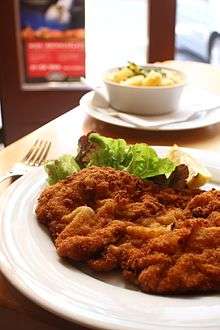 Wiener schnitzel from veal, as served in Vienna
Wiener schnitzel from veal, as served in Vienna.jpg) A Wiener Schnitzel served in Carinthia, Austria
A Wiener Schnitzel served in Carinthia, Austria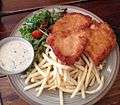 Chicken schnitzel with fries and salad
Chicken schnitzel with fries and salad Schnitzel platter consisting of veal, pork, and chicken schnitzels, served with mashed potatoes, beetroot, mushroom cream sauce and side salad
Schnitzel platter consisting of veal, pork, and chicken schnitzels, served with mashed potatoes, beetroot, mushroom cream sauce and side salad Swiss schnitzel, served with french fries and side salad
Swiss schnitzel, served with french fries and side salad Surf and turf schnitzel: a chicken schnitzel topped with prawns and served with french fries
Surf and turf schnitzel: a chicken schnitzel topped with prawns and served with french fries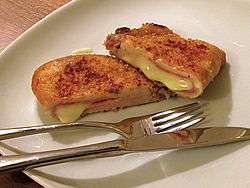 A cordon bleu schnitzel
A cordon bleu schnitzel
See also
- Cotoletta alla milanese – breaded veal cutlet
- Karađorđeva šnicla – a kind of cordon bleu
- List of veal dishes
References
- American Heritage Dictionary of the English Language, s.v.
- Püttmann, Hermann (1845). Bibliothek der deutschen Literatur / Rheinische Jahrbücher zur gesellschaftlichen Reform. Druck und Verlag von C.W. Leske. p. 259. OCLC 310973411.
- Wiener Schnitzel Archived 2012-02-25 at the Wayback Machine
- "Wiener Schnitzel – Austria's National Food". All Things Austria. 2010-12-13. Retrieved 2017-10-29.
- "Wiener Schnitzel". Hunter Angler Gardener Cook. 2012-12-21. Retrieved 2017-10-29.
- June Meyers Authentic Hungarian Heirloom Recipes Cookbook
- 岡田, 哲. とんかつの誕生―明治洋食事始め. p. 166.
- 小菅, 桂子. にっぽん洋食物語大全. p. 122.
- Kaneko, Amy (2007). Let's Cook Japanese Food!: Everyday Recipes for Home Cooking. Chronicle Books. p. 101. ISBN 0-8118-4832-9.
- Jennifer Ellen Robertson, ed. (2005). A companion to the anthropology of Japan. Wiley-Blackwell. p. 421. ISBN 0-631-22955-8.
- "Șnițél". dexonline.ro (in Romanian).
- Schläpfer, Beat (1998). Swiss, made: die Schweiz im Austausch mit der Welt. Scheidegger & Spiess.
- "BBC - Tees Parmo! - Teesside Parmesan recipe". Retrieved 16 January 2018.
| Wikibooks Cookbook has a recipe/module on |
| Wikimedia Commons has media related to Schnitzel. |
| Look up schnitzel in Wiktionary, the free dictionary. |